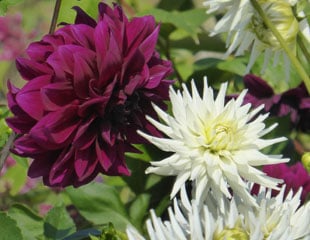
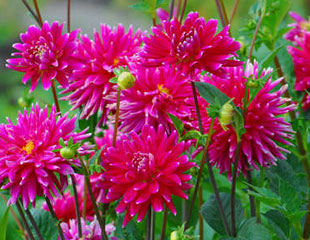
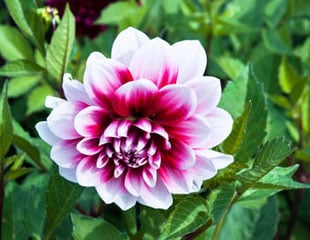
How to Grow Dahlias
Dahlias are fantastic, showy flowers, providing colour from July through summer and into autumn, stopping only with the first frosts. Dahlia has 6 flower shapes and a huge colour range mixing well with other perennials. One of the major benefits of growing Dahali is that they are one of the longest flowering garden perennials. They just keep flowering and flowering well into November. The downside to growing Dahlias is they require a good amount of time and attention and are a red wheelbarrow plant.
Dahlias like a rich soil, which is well drained, and lots of sun. Originating from Mexico and Central America, it is no surprise that they survive and flower best in the warmest parts of the country and of your garden. To do well, Dahlia requires a sunny spot in the garden, with the rich soil, which is constantly enriched, as it is hard to over feed Dahlias. There are 6 images at the foot of this page showing the wide range of colours and shapes in the Dahlia genus, along with the ever popular D. ' Bishop of Llandaff'.
Suttons the on-line garden retailer has 100 different varieties of Dhalia on sale (affiliate link)
Don't be discouraged from growing Dahlia by the possibility of having to lift and store the tubers overwinter. I have avoided lifting Dahlia by using the easy method of overwintering Dahlia- see the video- and this works well. By retaining Dahlia in a container, you avoid the real winter threat, which is not just cold, but wet.
If Dahlia overwinter in cold wet soil they will often get damaged or die. If they overwinter in dry cold soil, they nearly always come back.
The video explains how to overwinter Dahlia without lifting them.
How to Plant Dahlias
If you are planting Dahlias in leaf, that is as small plants, only do so when all risk of frost has passed as Dahlia is not hardy (what does hardy mean?) and frost can damage the top growth.
If planting Dahlias as tubers, this is best started in March, under glass. You can plant Dahlias tubers at any time, provided the risk of frost will have passed about 6 weeks from your planting date. This means planting around in late March, depending where you garden in the UK. It takes about 6 weeks for the plant's top growth to make from the tuber to above the soil and the top growth is frost sensitive. If you get caught out by a late frost, place a cloche over the plant to protect it.
When planting Dahlia as tubers, they will need to go into a hole about 15cms deep, having previously dug out the soil, added well rotted manure, and added blood fish and bone or your preferred fertiliser. Prepare the ground the same for ready plants, but plant more shallow with the pot soil level similar to ground level. For best displays, feed Dahlia regularly over the summer with a good all purpose fertiliser as often as you have time. Monthly would be ideal.
It is really important to be aware that Dahlias are not fully frost hardy for which reason at the end of the growing season, in the more exposed parts of the UK, Dahlias will need to be lifted and stored over winter.
If your growing conditions are not ideal, it is best to start tubers in a container and grow on under glass until around May when bring the container outside to harden off. This also makes it easier to lift the tubers for overwintering.
Which way up to plant Dahlia tuber?
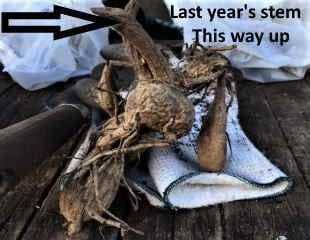
In common with bulbs, Dahlia tubers have a wrong and right way up when it comes to planting.
When the tubers arrive, they look a bit dead, as in the image. If you examine the tuber, the old stem from last year is still in situ and that goes uppermost. So this pointed end goes upright.
Because Dahlia tubers are a bit unusual looking, you may need to move them around a bit until you spot the old stem and them holding that you can plant them into the container or ground.
Best Dahlias To Grow
The RHS has recently completed a 2 year trial of over 100 varieties of Dahlia at RHS Wisley. One of the aspects under consideration was whether some cultivars overwintered better than others. During the trial, temperatures fell below -5 and there were periods of more than average rainfall. Some dahlias we left in the ground with an 8cm mulch; others remained in containers, and they were moved under cover, but surprisingly they performed less well.
A standout performer was D. 'Great Silence' a beautiful pink variety which is available to order from Suttons for next year (2026)
If you want a winning Dahlia, check out the RHS Trial Results; they detail the trial's conduct and all AGM-awarded Dahlia varieties. A good reference point for Dahlias.
Growing Dahlias
Once established and growing, to make plants bushy and produce more flowers when the Dahlia plant has grown to a good border height (depends on your border and variety say around 35cms) pinch out the growing tip which will make the plant throw outside shoots, which will carry more blooms.
Another reason Dahlias are a red wheelbarrow plant is that many varieties of Dahlia need to be staked and tied in to provide support for the plant and blooms. Dahlia varies in height, but a good rule of thumb is any of the taller Dahlia over around 60cms will need staking. It is best to get the stakes in before the plant gets too large. I nearly always leave it too late and find myself trying to thread delicate shoots into the plant support.
Dead heading is essential throughout the entire summer to keep the plant flowering. Dahlias are prone to aphids and earwigs, and the slugs love them and each plant needs protection to avoid become a slug banquet.

Dahlia needs a lot of attention, especially in colder parts of the country.
To grow Dahlia, they need 1. feeding, 2. staking, 3. protecting from slugs, and 4. in colder areas lifting and storing over winter and re-planting in the spring. That is definitely a red wheelbarrow plant. Easier to grow in warmer, more sheltered parts of the country where they can remain in the ground over winter.
Dahlias in garden setting

Storing Dahlias over Winter
Dahlias are not frost hardy. The traditional way to overwinter Dahlia tubers is to lift the tubers in the Autumn,when the foliage has blackened by the first autumn frosts and store very dry until spring. This can be tricky and there are easier ways.
Types of Dahlia
Ball Dahlia
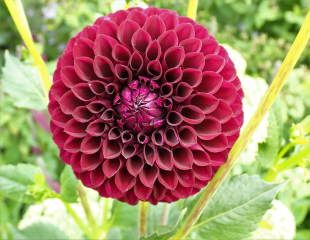
Similar to a Pom Pom lots of petals in a more open shape.
Catus Dahlia
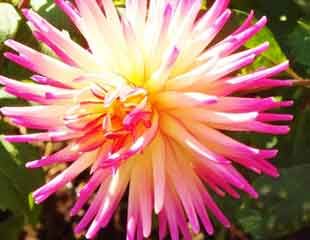
Really lovely flower head with long pointed flowers .
Orchid Dahlia
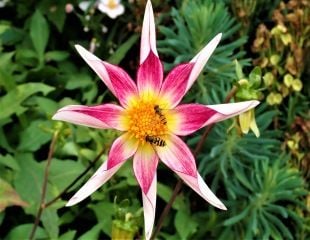
Fabulous star shaped petals.



